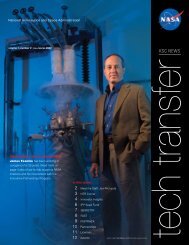2006-2007 - Kennedy Space Center Technology Transfer Office
2006-2007 - Kennedy Space Center Technology Transfer Office
2006-2007 - Kennedy Space Center Technology Transfer Office
- No tags were found...
You also want an ePaper? Increase the reach of your titles
YUMPU automatically turns print PDFs into web optimized ePapers that Google loves.
In an ongoing effort for improvement,the locomotive assembly was replacedby a state-of-the-art shaker assembly.Four diaphragms, each with a differentstiffness, were attached to the peripheryof their tanks so that the effects of sloshon each could be studied (Figure 3).These new transparent spherical fueltanks with diaphragms will be mountedon a fixture and linearly oscillated bythe shaker. The forces at the tank wall,along the axis of lateral motion, will bemeasured by a force transducer mountedon the fixture, similar to what was donewith the locomotive assembly.Diaphragms provide a substantial levelof slosh damping as a result of thecombination of viscoelastic flexing ofthe diaphragm and the increased viscouseffects at the liquid-diaphragm interface.It is assumed that, as the stiffness ofthe diaphragm increases, the pendulumdamping parameter will increase, as wasobserved on free-surface tests of fluidswith higher viscosities. The presence ofa diaphragm in the fuel tank should alsoincrease the natural frequency of the sloshbecause of the constraints imposed onthe free-surface shape. In addition, theeffective mass of liquid participating inthe sloshing will most likely be smallerthan that for a tank of the same shapeand fill level without a diaphragm. Thatis, a greater percentage of fluid willbehave as if it were attached to the tank.Figure 4 shows the new slosh test facilitydesigned, fabricated, and installed atEmbry-Riddle Aeronautical Universityto investigate the lateral sloshing ofspacecraft propellant tanks.Amplitude Out0.30.20.10–0.1–0.2–0.3Measured vs. Simulated ResponsesNew Data–0.40 1 2 3 4 5 6 7 8 9 10Time (s)Figure 2. Corn syrup: 60-percent fill level, oscillating at 1.75 Hz (unit = lbf).Figure 3. Experimental setup with the diaphragm.Contacts: James E. Sudermann , NASA-KSC,(321) 867-8447; and Keith L. Schlee, AnalexCorporation, (321) 867-4186Participating Organizations: Embry-Riddle Aeronautical University (Dr. SathyaGangadharan, Yadira Chatman, and BrandonMarsell) and Hubert Astronautics, Inc.(Dr. Carl Hubert)Figure 4. New slosh test facility at Embry-Riddle Aeronautical University.KSC <strong>Technology</strong> Development and Application <strong>2006</strong>-<strong>2007</strong>85













